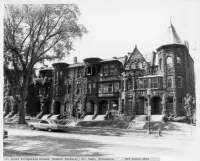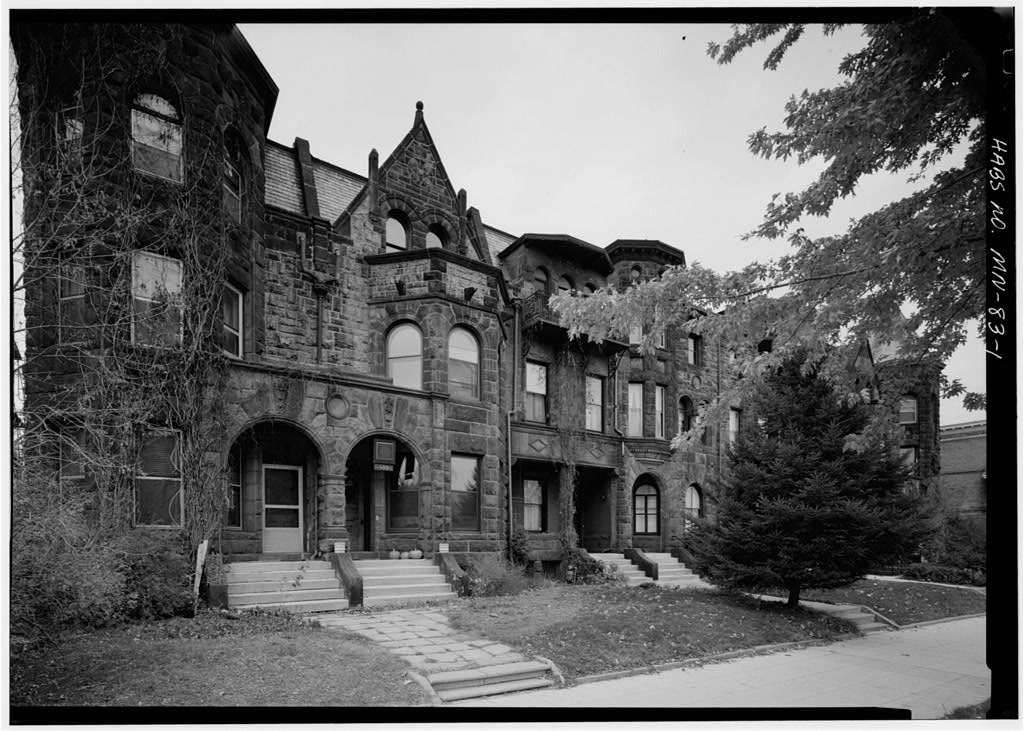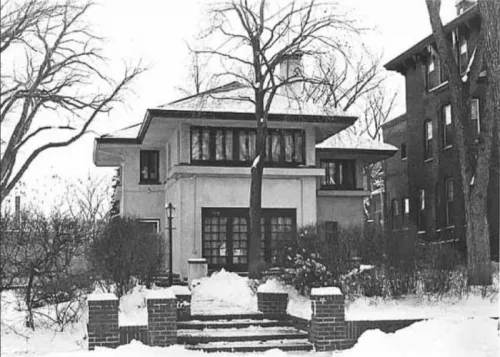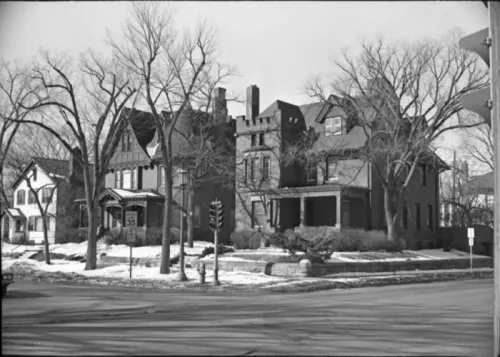Share what you know,
and discover more.
Share what you know,
and discover more.
Nov 11, 1971

-

- Dave D
National Register of Historic Places
Statement of Significance: During the 1920s when such works as The Great Gatsby had brought F. Scott Fitzgerald to the height of his reputation, he embodied the essence of the disillusioned post-war literary outlook. "He was that rare kind of writer, a genuine microcosm with a real gift of objectivity. This combination explains his success. It is the reason that the force of his best work always transcends its subject matter." As his later works proved Fitzgerald was much more than a spokesman for a generation. His greatest contribution stemmed from his ability to forge his insights into lasting works of art. The family of F. Scott Fitzgerald moved to 593 Summit Avenue about 1914 and lived there until 1918. They then moved to another house in the same row, number 599, which became their permanent home in St. Paul. As Scott had become a boarder at Newman Academy in 1911 and then attended Princeton from 1913 to 1917, he returned to St. Paul only for vacations during these years. In July 1919, however, he returned to 599 Summit Avenue and set to work on a protracted literary effort. Using an earlier, rejected manuscript as a basis, Fitzgerald created his first published novel. This Side of Paradise, which inaugurated his fame. After the completion of this novel, he remained at the house until November, writing short stories. He also returned for the Christmas holidays but departed for New Orleans in January 1920. Although Summit Terrace was only one of several St. Paul locations in which Fitzgerald lived, it typifies the environment on which he drew for some of the finest of his later stories. Number 599 is the St. Paul house most significantly associated with the productive period of the author's career, and it memorializes a crucial phase of his development. Although the interiors of the houses in which Fitzgerald lived have been somewhat modified, their exteriors are virtually changed. The remainder of the row, which forms their integral setting, appears to maintain the same degree of integrity. Biography: Francis Scott Key Fitzgerald was born in 1896 in St. Paul Minnesota and spent most of his boyhood there and in New York State. In 1913, he entered Princeton University, where his social life and extra-curricular activities limited his academic achievement. He left college in 1917 to join the Army but was never sent overseas to the war zone. While stationed in Alabama he met Zelda Sayre, to whom he became engaged. During his military service, he completed The Romantic Egoist, a novel about a young man's initiation into life, which was rejected for publication. After being demobilized, he found a job with an advertising agency in New York and wrote short stories, only a few of which he was able to market. His prospects appeared so uncertain that Zelda felt obliged to discontinue their engagement. Fitzgerald then returned to his parents' house in St. Paul, where he purposefully rewrote and enlarged his novel. When the new work appeared in 1920 as This Side of Paradise it achieved enormous success and won for its author the reputation of prime spokesman for the glamorous and emancipated youth of the Jazz Age. Fitzgerald was now able to marry Zelda, and the young couple embarked on a heady period of fame and prosperity during which they sojourned in France and took up residence in various parts of the United States. Besides volumes of short stories, Fitzgerald soon published another novel. The Beautiful and Damned. (1922). Three years later he published the novel usually considered to be his finest. The Great Gatsby. This carefully crafted work was a striking parable of aspiration and desire and is often considered to be one of the greatest novels in American literature. As Arthur Mizener has written, "The art of this book is nearly perfect." Despite his success, Fitzgerald was increasingly troubled by his own tendency to alcoholism and the growing mental illness of his wife. The panic of 1929 changed the nation's literary tastes as radically as its political outlook. When Fitzgerald's brilliant, Tender is the Night, appeared in 1934, it pleased neither the critics nor the public. Three years later, he went as a film scriptwriter to California, where he died of a heart attack in 1940. His final novel. The Last Tycoon was published in incomplete form the next year.
National Register of Historic Places
Statement of Significance: During the 1920s when such works as The Great Gatsby had brought F. Scott Fitzgerald to the height of his reputation, he embodied the essence of the disillusioned post-war literary outlook. "He was that rare kind of writer, a genuine microcosm with a real gift of objectivity. This combination explains his success. It is the reason that the force of his best work always transcends its subject matter." As his later works proved Fitzgerald was much more than a spokesman for a generation. His greatest contribution stemmed from his ability to forge his insights into lasting works of art. The family of F. Scott Fitzgerald moved to 593 Summit Avenue about 1914 and lived there until 1918. They then moved to another house in the same row, number 599, which became their permanent home in St. Paul. As Scott had become a boarder at Newman Academy in 1911 and then attended Princeton from 1913 to 1917, he returned to St. Paul only for vacations during these years. In July 1919, however, he returned to 599 Summit Avenue and set to work on a protracted literary effort. Using an earlier, rejected manuscript as a basis, Fitzgerald created his first published novel. This Side of Paradise, which inaugurated his fame. After the completion of this novel, he remained at the house until November, writing short stories. He also returned for the Christmas holidays but departed for New Orleans in January 1920. Although Summit Terrace was only one of several St. Paul locations in which Fitzgerald lived, it typifies the environment on which he drew for some of the finest of his later stories. Number 599 is the St. Paul house most significantly associated with the productive period of the author's career, and it memorializes a crucial phase of his development. Although the interiors of the houses in which Fitzgerald lived have been somewhat modified, their exteriors are virtually changed. The remainder of the row, which forms their integral setting, appears to maintain the same degree of integrity. Biography: Francis Scott Key Fitzgerald was born in 1896 in St. Paul Minnesota and spent most of his boyhood there and in New York State. In 1913, he entered Princeton University, where his social life and extra-curricular activities limited his academic achievement. He left college in 1917 to join the Army but was never sent overseas to the war zone. While stationed in Alabama he met Zelda Sayre, to whom he became engaged. During his military service, he completed The Romantic Egoist, a novel about a young man's initiation into life, which was rejected for publication. After being demobilized, he found a job with an advertising agency in New York and wrote short stories, only a few of which he was able to market. His prospects appeared so uncertain that Zelda felt obliged to discontinue their engagement. Fitzgerald then returned to his parents' house in St. Paul, where he purposefully rewrote and enlarged his novel. When the new work appeared in 1920 as This Side of Paradise it achieved enormous success and won for its author the reputation of prime spokesman for the glamorous and emancipated youth of the Jazz Age. Fitzgerald was now able to marry Zelda, and the young couple embarked on a heady period of fame and prosperity during which they sojourned in France and took up residence in various parts of the United States. Besides volumes of short stories, Fitzgerald soon published another novel. The Beautiful and Damned. (1922). Three years later he published the novel usually considered to be his finest. The Great Gatsby. This carefully crafted work was a striking parable of aspiration and desire and is often considered to be one of the greatest novels in American literature. As Arthur Mizener has written, "The art of this book is nearly perfect." Despite his success, Fitzgerald was increasingly troubled by his own tendency to alcoholism and the growing mental illness of his wife. The panic of 1929 changed the nation's literary tastes as radically as its political outlook. When Fitzgerald's brilliant, Tender is the Night, appeared in 1934, it pleased neither the critics nor the public. Three years later, he went as a film scriptwriter to California, where he died of a heart attack in 1940. His final novel. The Last Tycoon was published in incomplete form the next year.
Nov 11, 1971
National Register of Historic Places
Statement of Significance:During the 1920s when such works as The Great Gatsby had brought F. Scott Fitzgerald to the height of his reputation, he embodied the essence of the disillusioned post-war literary outlook. "He was that rare kind of writer, a genuine microcosm with a real gift of objectivity. This combination explains his success. It is the reason that the force of his best work always transcends its subject matter." As his later works proved Fitzgerald was much more than a spokesman for a generation. His greatest contribution stemmed from his ability to forge his insights into lasting works of art.
The family of F. Scott Fitzgerald moved to 593 Summit Avenue about 1914 and lived there until 1918. They then moved to another house in the same row, number 599, which became their permanent home in St. Paul. As Scott had become a boarder at Newman Academy in 1911 and then attended Princeton from 1913 to 1917, he returned to St. Paul only for vacations during these years. In July 1919, however, he returned to 599 Summit Avenue and set to work on a protracted literary effort. Using an earlier, rejected manuscript as a basis, Fitzgerald created his first published novel. This Side of Paradise, which inaugurated his fame. After the completion of this novel, he remained at the house until November, writing short stories. He also returned for the Christmas holidays but departed for New Orleans in January 1920. Although Summit Terrace was only one of several St. Paul locations in which Fitzgerald lived, it typifies the environment on which he drew for some of the finest of his later stories. Number 599 is the St. Paul house most significantly associated with the productive period of the author's career, and it memorializes a crucial phase of his development.
Although the interiors of the houses in which Fitzgerald lived have been somewhat modified, their exteriors are virtually changed. The remainder of the row, which forms their integral setting, appears to maintain the same degree of integrity.
Biography:
Francis Scott Key Fitzgerald was born in 1896 in St. Paul Minnesota and spent most of his boyhood there and in New York State. In 1913, he entered Princeton University, where his social life and extra-curricular activities limited his academic achievement. He left college in 1917 to join the Army but was never sent overseas to the war zone. While stationed in Alabama he met Zelda Sayre, to whom he became engaged. During his military service, he completed The Romantic Egoist, a novel about a young man's initiation into life, which was rejected for publication. After being demobilized, he found a job with an advertising agency in New York and wrote short stories, only a few of which he was able to market. His prospects appeared so uncertain that Zelda felt obliged to discontinue their engagement. Fitzgerald then returned to his parents' house in St. Paul, where he purposefully rewrote and enlarged his novel. When the new work appeared in 1920 as This Side of Paradise it achieved enormous success and won for its author the reputation of prime spokesman for the glamorous and emancipated youth of the Jazz Age.
Fitzgerald was now able to marry Zelda, and the young couple embarked on a heady period of fame and prosperity during which they sojourned in France and took up residence in various parts of the United States. Besides volumes of short stories, Fitzgerald soon published another novel. The Beautiful and Damned. (1922). Three years later he published the novel usually considered to be his finest. The Great Gatsby. This carefully crafted work was a striking parable of aspiration and desire and is often considered to be one of the greatest novels in American literature. As Arthur Mizener has written, "The art of this book is nearly perfect."
Despite his success, Fitzgerald was increasingly troubled by his own tendency to alcoholism and the growing mental illness of his wife. The panic of 1929 changed the nation's literary tastes as radically as its political outlook. When Fitzgerald's brilliant, Tender is the Night, appeared in 1934, it pleased neither the critics nor the public. Three years later, he went as a film scriptwriter to California, where he died of a heart attack in 1940. His final novel. The Last Tycoon was published in incomplete form the next year.
Posted Date
Jan 22, 2022
Historical Record Date
Nov 11, 1971
Source Name
United States Department of the Interior - National Park Service
Delete Story
Are you sure you want to delete this story?
Jun 01, 1963
Jun 01, 1963
Summit Terrace, 587-601 Summit
587-601 Summit Avenue, Saint Paul, Ramsey County, Minnesota, United StatesApproximately 1963
Posted Date
Jan 05, 2022
Historical Record Date
Jun 01, 1963
Source Name
Minnesota Historical Society
Delete Story
Are you sure you want to delete this story?

-

- Marley Zielike
F. Scott Fitzgerald House, 599 Summit Ave Saint Paul, Ramsey County, MN
Fitzgerald family home where F. Scott Fitzgerald completed his first novel, "This Side of Paradise" in 1920, beginning his fame. Fitzgerald, said to be a spokesman for his generation, embodied the essence of disillusioned post-war outlook.
F. Scott Fitzgerald House, 599 Summit Ave Saint Paul, Ramsey County, MN
Fitzgerald family home where F. Scott Fitzgerald completed his first novel, "This Side of Paradise" in 1920, beginning his fame. Fitzgerald, said to be a spokesman for his generation, embodied the essence of disillusioned post-war outlook.
F. Scott Fitzgerald House, 599 Summit Ave Saint Paul, Ramsey County, MN
Fitzgerald family home where F. Scott Fitzgerald completed his first novel, "This Side of Paradise" in 1920, beginning his fame. Fitzgerald, said to be a spokesman for his generation, embodied the essence of disillusioned post-war outlook.Posted Date
Sep 27, 2021
Source Name
Library of Congress
Source Website
Delete Story
Are you sure you want to delete this story?
















